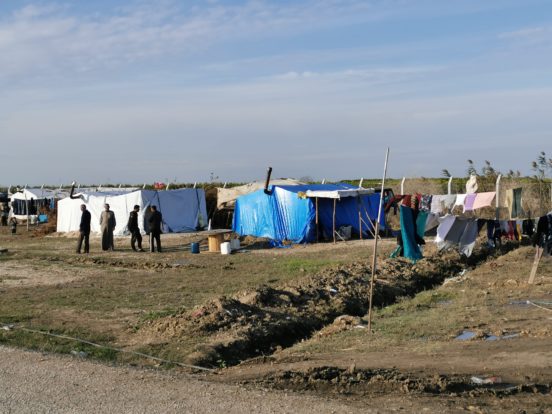People living in the Global North might argue that the coronavirus pandemic (COVID-19) is the greatest existential threat to life as we know it in the last 100 years. Yet for Syrians, the pandemic, while undeniably traumatic, is just one more event in a litany of equally-devastating hardships that have proven inescapable, difficult and necessary to endure.
Years of protracted conflict mean that Syrians have become inured to living with significant risks and uncertainties about their future lives and livelihoods. While the attention and resources of apparent former ‘global health powerhouses’ like the UK and USA, are fixed on solving challenges posed by disease transmission and constraints on healthcare systems in their own countries, there is a growing danger that the impacts of disease incursion on displaced and vulnerable populations in fragile and conflict-affected states may be completely neglected. In countries everywhere, ensuring access to appropriate healthcare is the immediate priority in this outbreak. But in countries like Syria, effective solutions are also needed to support other types of life-sustaining interventions, such as local and cross-border distribution of food and agricultural inputs which facilitate labour, militate loss of income and prevent food insecurity and its attendant effects on starvation, malnutrition and mental health and well-being A successful response to this pandemic will therefore depend not just on top-down public-health interventions, but also uptake of cross-sectoral, culturally appropriate and locally-led approaches which translate high-level strategies derived not only from security, but also humanitarian and development agendas, into concrete policies and impactful activities on the ground. In Syria, where there are uncertainties about governance and weakened institutions, a community-led response to COVID-19 is a matter of increasing urgency.
Challenges of implementing effective disease mitigation efforts in Syria
There are currently more than 4.7 million reported world-wide cases of COVID-19 and more than 315,000 COVID-related deaths (as of 18 May 2020). The risks to individuals from coronavirus are great: there is currently no vaccine, no cure and there is a non-negligible likelihood that intensive hospital care may be required for a realistic chance at recovery. We are still learning about the multi-systemic consequences of the disease; for some long-term health sequelae persist long after recovery.
More than a decade of civil war and a collapsing economy have forced 6 million or more Syrians into crowded living conditions along the Syrian border, into neighbouring countries and failed states with fragile and fragmented healthcare systems. Syria is currently ranked as one of the least prepared countries in the world for emergency disease outbreak preparedness and response. Reported cases of COVID-19 in Syria are currently small in number (n= 59) but there are fears that most remain undetected due to inadequate testing capacity and an absence of functioning health centres. On the ground, it is becoming evident that few people are attending workshops or meetings delivering information about COVID-19, with most information about COVID-19 being obtained through social media. The lack of public trust in the Syrian government, general lack of knowledge about clinical signs of disease and concurrent gaps in information campaigns, alongside fears over possible repercussions (including discrimination, detainment, disappearance), mean that people are deterred from seeking testing or treatment even if that capability were available to them.
International aid is promised to support outbreak response efforts in Syria, but challenging to operationalise. Responders need to negotiate for permission with multiple local and international authorities, state- and non-state actors in border areas. Some NGOs are responding to the crisis in Northwest and Northeast Syria under the cross-border resolution, but this vital aid may be under threat if the UN Security Council does not overcome Russian and Chinese objections to the renewal (in July).
A curfew in government-controlled areas was initially put in place to encourage people to stay in their homes to reduce their risks of disease exposure and onward transmission. It is not at all evident that this made them safer or healthier. Individuals still need to leave home to collect their incomes- “I don’t have another choice … to survive”. “At home” for many Syrians is typically an overcrowded, physically and mentally stressful environment, without access to adequate supplies of food or other products. Conditions are far worse for those who live in north Syrian camps, where inadequate access to basic medical, water and sanitation facilities is commonplace and a single tent may shelter as many as five to 15 people. In Northeast Syria, for example, there are over 225,000 IDPs and refugees living in last resort sites without reliable or sufficient access to essential services such as health, WASH and shelter. Although face masks and disinfection liquids may be available in some markets in north Syria, most people can’t buy them- “these are available, but we don’t have income to purchase it. My priority is to purchase essential food items to survive”. Outside Syria, the UNHCR is trying to ensure that there is full inclusion of refugees in the preparedness, prevention and response measures to the COVID-19 pandemic in the region, but it is unclear what provisions are available to Syrian refugees if the capacity of healthcare systems in host countries is overloaded.
COVID-19 impacts on humanitarian efforts and longer-term food security and livelihoods in Syria
Since mid-March, significant price increases in fuel and some shortages in basic goods, essential food items, and personal sterilization and protection items (such as face masks, hand sanitizers) have been reported across Syria. The exchange rate has weakened since mid-March to the lowest point on record. These factors, in combination with panic-buying, disrupted supply routes, reduced shop opening hours, reduced working hours, wages and household incomes and movement restrictions are likely to deepen pre-existing vulnerabilities.
Established survival mechanisms, which are traditionally relied on by displaced Syrians to cope with informality and lack of economic support (e.g. through transnational kinship support networks, early marriage, and child labour) may become distorted over the next weeks and months, leading to other unintended, negative consequences. Among the most vulnerable in Syrian society are day labourers, who depend on daily wages to cover the basic needs for their family. For displaced Syrians with no financial safety net, staying at home immediately worsens food security for entire households. Small-scale farmers and migratory agricultural workers in neighbouring countries will be affected too. Farmers will lose access to extension services, be hindered from working or hiring workers to help with the harvest commencing in May, and many will struggle to eat due to higher food prices/limited purchasing power due to their already insecure employment, legal status, and low-wages. Moreover, the pandemic will have important subsequent impacts on livestock sector due to reduced access to animal feed, vaccination and extension services.
The longer-term costs and indirect impacts of COVID-19 on Syria’s reconstruction efforts and sustainable development will not be known for the foreseeable future. However, undoubtedly, Syrians and other peoples in fragile and conflict-affected states will feel the brunt of COVID-19 impacts, only serving to widen existing inequality gaps which will endure into future generations. In the face of the uncertainty surrounding the COVID-19 outbreak, the 2030 “blueprint for shared prosperity in a sustainable world” offered by the UN Sustainable Development Goals (SDG), Syria and other places like it, is surely in jeopardy. A deep commitment for international cooperation as well as for peace-building and transitional justice will be needed. How countries decide to support Syria during and after this health crisis, will be pivotal to the future of global health security – “a disease anywhere is a disease everywhere”. But what happens next will undoubtedly depend on how those countries themselves, weather this storm.
Authors: Dr Lisa Boden, Dr Ann-Christin Wagner, Dr Shaher Abdullateef and Dr Anas Al Kaddour are collaborating with other researchers from the Universities of Edinburgh and Aberdeen, and project partners from CARA (Council for At-Risk Academics) Syria Programme, on a SFC-GCRF COVID-19 grant for research with displaced Syrians in Lebanon, Jordan, Turkey, Iraqi Kurdistan and Northwest Syria.
Their new “From the FIELD” project uses remote surveys and ethnography to assess the impact of COVID-19 on local food supply chains and displaced people’s agricultural livelihoods in the Middle East. For updates, follow the team members on Twitter: @Lisa_A_Boden, @ann_wagner_ed and @ShaherAbdulla










Comments by Ritti Soncco